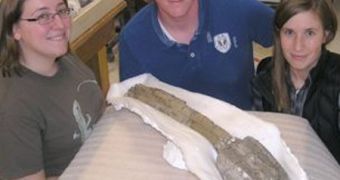Three students from the University of Alberta, in Canada, have recently contributed to clearing up a mistake that has endured in the field of paleontology since the 1970s. Through their work, they helped revert a dinosaur species to a more suitable classification. In an odd twist, the new classification is the same as the original one, which the species received in 1924 from the expert who originally discovered it, the late Canadian paleontologist William Parks. The dinosaur toes that were used for the new work were found more than 85 years ago, in southern Alberta, PhysOrg reports.
“From a partial set of fossilized bones, Parks concluded that it was a new species of anklyosaur that he named Dyoplosaurus, or double-armored dinosaur. But in the 1970s a new set of researchers came along and reclassified Park's find as another anklyosaur species called Euoplocephalus,” Victoria Arbour, a PhD candidate at the University of Alberta, and one of the three students who have conducted the new work, explains the mix-up. The dinosaur is about 76 million years old and is believed to have been about four meters (about 13 feet) long. Paleontologists say it resembled an armadillo in shape.
“We were all interested in anklyosaurs, but we were all focused on different parts of the skeleton,” Mike Burns, another one of the students, adds. He was interested in examining the dinosaur's skull and body armor. Colleague Robin Sissons was interested in the feet and limb mechanics of the fossilized bones, whereas Arbour looked at the pelvis and the tail of the creature. The investigation was conducted at the Royal Ontario Museum, in Toronto, Canada.
“There was something different about the toes on this specimen. It didn't match the structure of the dinosaur species it had been reassigned to by the 1970s researchers,” Sissons says. As soon as the team started looking closely into the 1970s classification, faults began to spring up. “I found the pelvis didn't match up with what we know about Euoplocephalus,” Arbour shares. Burns also found inconsistencies in the texture of the dinosaur's armor, so the three knew that they had found a mistake in the former classification.
“I went to the American Museum of Natural History in New York and examined their anklyosaur collection. I found the same small differences that confirmed for us Parks had identified his dinosaur correctly as Dyoplosaurus,” Arbour adds. “The Eureka moment passed quietly. The 1970s researchers didn't think Parks' find was different enough from other anklyosaur finds to warrant classification as a separate species.” Details of the work appear in this month's issue of the respected Journal of Vertebrate Paleontology.

 14 DAY TRIAL //
14 DAY TRIAL //